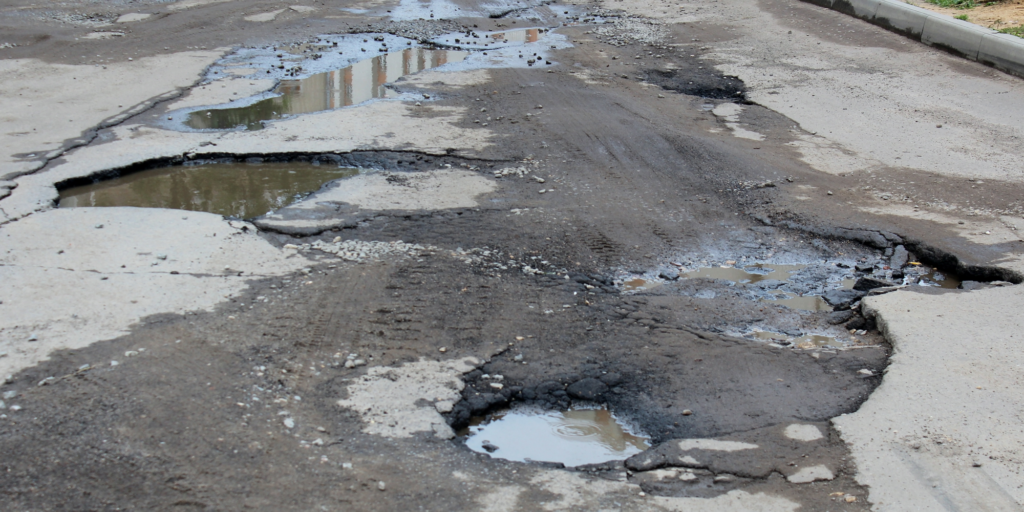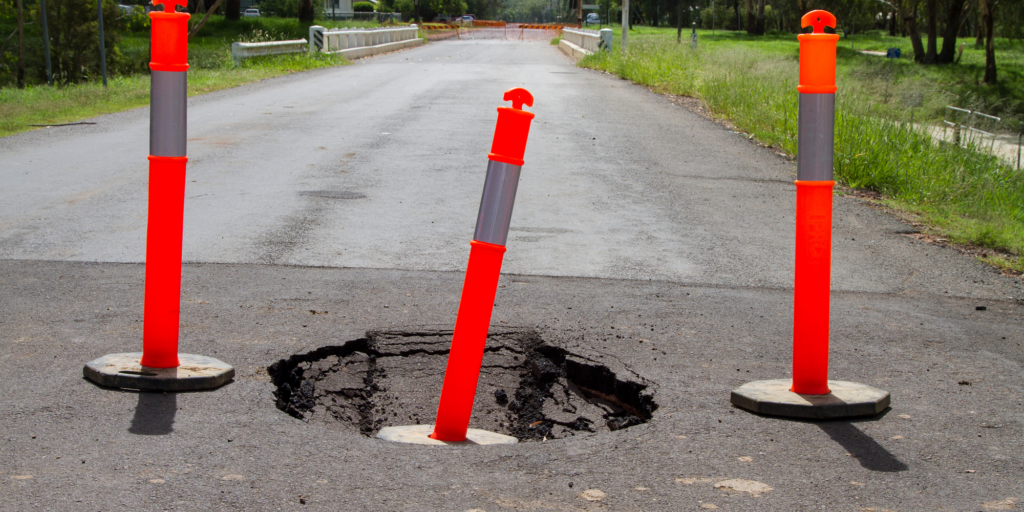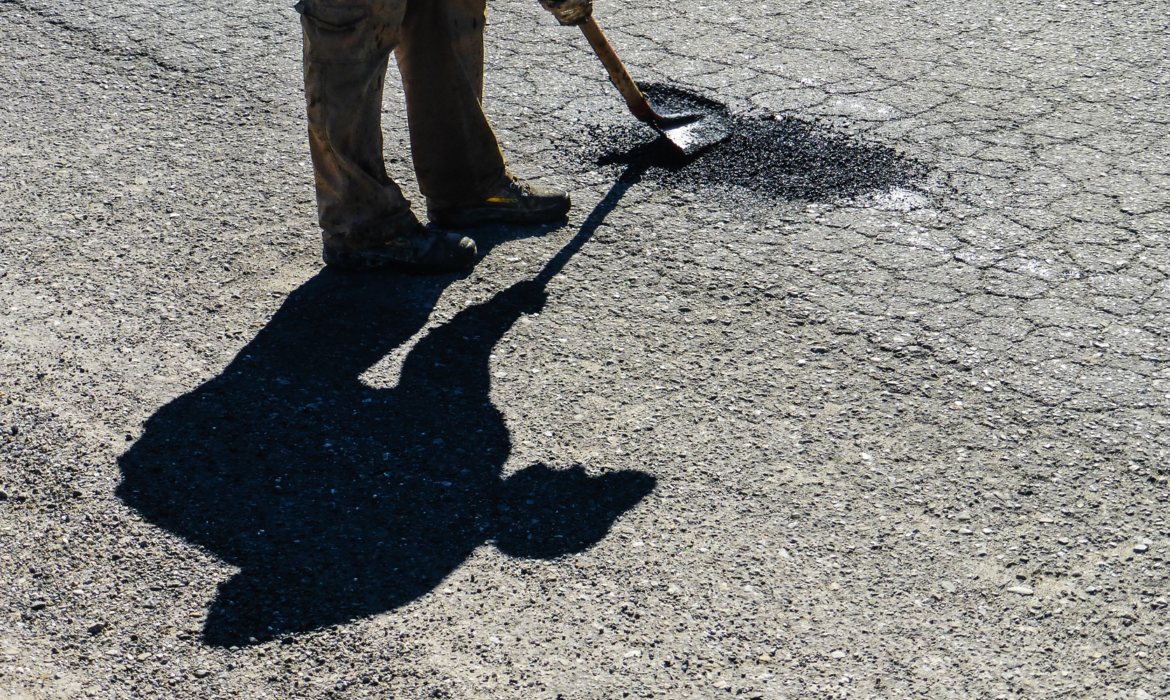Join us as we explore potholes in our latest blog post! Oh, those pesky craters that emerge out of nowhere and ruin our asphalt roadways. Fear not, my reader, for today we will reveal the secrets of these tire-eating nuisances and learn how to fix them professionally.
What are potholes?
What are potholes? Imagine driving on a sunny day with your favorite music and the breeze in your hair. You hit a bump unexpectedly, shaking your car. Congratulations! You hit a pothole.
Potholes are smaller craters on roadways and pavements. They range in size and depth from little pests to tire-swallowing monsters. Nature’s relentless forces and daily wear and tear generate these depressive episodes.
Water seeping into pavement cracks or weak spots starts it. This trapped water freezes and expands in those spaces when temps dip below freezing (cue dramatic music). Increasing ice pressure weakens surrounding materials.
The interesting part is that when that frozen water melts due to warmer weather or passing vehicles, it leaves behind empty pockets beneath the surface, ready to be filled with rainwater or snow.
These voids spawn future potholes, starting an infinite cycle of expansion and contraction. When a vehicle travels over these weak places, tires loosen and carry debris, deepening or forming new holes.
Interesting stuff! Fear not—we’re only beginning our path to smooth roads. Brace yourself—we’ll explain how potholes arise next!

How do potholes form?
How do potholes form? Many drivers ask themselves on bumpy roads. Potholes are irritating and dangerous, and damage automobiles. What causes these annoying road imperfections?
Cracks in asphalt cause potholes. Heavy traffic, freezing and thawing cycles, and water intrusion can produce fissures. Water seeping through gaps and freezing in cold weather undermines the pavement.
The asphalt degrades progressively as vehicles travel over weakened places. Heavy automobiles and trucks stress the already damaged structure, causing pavement pieces to fall off.
Potholes can also result from inadequate construction or maintenance. Roads will crack and deteriorate if not built or rebuilt appropriately using quality materials.
Weather, traffic, water infiltration, and poor construction or upkeep cause potholes. Understanding how road nuisances occur is crucial to developing effective solutions, which we’ll discuss next!
How to fix a pothole
Fixing asphalt potholes requires a few procedures to ensure success. First, gather the tools and materials. Shovels, asphalt patching material, tampers or compactors, gloves, and goggles are usually needed.
Start by cleaning the pothole after gathering your supplies. Remove any vegetation or loose debris. A clean surface may help the mending material stick.
Fill the pothole using asphalt patching material. Spread it evenly and slightly overfill the hole. Firmly compact the material using your tamper or compactor.
Determine if more material is needed to fill the hole after compacting. Repeat until the pothole is filled and level.
Traffic should wait until the repairing material heals. This takes 24-48 hours, weather permitting.
Maintaining asphalt surfaces can prevent potholes!
How to prevent potholes
Every driver hates potholes. They appear unexpectedly, damaging our tires and suspension. What if we could prevent potholes? Keep your asphalt smooth and pothole-free with these strategies.
Regular upkeep is crucial. Asphalt cracks and depressions should be repaired immediately. Small issues can soon become huge ones if ignored.
Next, drainage is essential. Potholes can be avoided by keeping water from pooling on pavement. Clear debris from gutters and direct water away from the surface.
Additionally, using high-quality materials during building or maintenance might make all the difference. Durable asphalt mixes and competent installation will create longer-lasting, pothole-resistant pavements.
When applicable, use traffic management measures. Finding alternative routes or scheduling deliveries during off-peak hours may decrease road damage from heavy vehicles.
These precautions can reduce the likelihood of potholes on your driveway or nearby roads.

Conclusion
Potholes are prevalent and can damage roads and automobiles. Maintaining safe and smooth roads requires understanding how they form and being proactive in repair and prevention.
This article explained potholes and their formation. We now know that water infiltration, freezing temperatures, traffic wear, and inadequate construction or maintenance produce potholes.
Potholes can be repaired in numerous ways depending on their severity. Each option, from cold asphalt patching to infrared heating or full-depth repairs, has pros and downsides.
Prevention is better than cure, as the adage goes. Prevention is key to avoiding potholes. Potholes can be prevented by regular inspections, crack sealing, drainage management, and employing high-quality materials during construction or restoration.
Municipalities and transportation organizations must prioritize infrastructure maintenance funds to address these concerns quickly. We can save money and make roads safer by investing in regular road maintenance rather than waiting for major damage.
Remember that reporting cracks or depressions early might help prevent road deterioration.
Next time you hit a pothole on your commute or local street, know that there are practical ways to fix it and avoid it. Let’s work for smoother rides!

